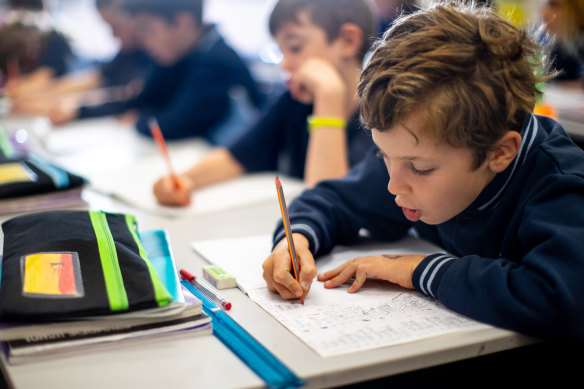
Government funding to West Australian private schools has increased significantly over the past decade, while over the same period funding to public schools declined.
The revelation was contained in the Productivity Commission’s latest Government Services Report on childcare, education and training, released on Tuesday.
Students from public schools in WA received less funding in 2021 than they did 10 years ago.Credit:Simon Schluter
While funding to government schools is 1.8 per cent lower in 2021 than it was in 2011, funding to private schools has climbed by 15.6 per cent.
WA was the only state in Australia where funding per student has declined.
Government schools received $21,026 per student, while non-government schools received $12,385.
The state government funded $3423 per student in private schools, compared to $17,831 per student at public schools. The remaining money came from the federal government.
Nationally in 2020-21, government recurrent expenditure on school education was $72.2 billion, a 1.0 per cent real increase from 2019-20.
Under the Gonski funding model, the federal government has committed to spending a record $318.9 billion on schools between 2018 and 2029.
The commission’s report has also revealed that where you live has the biggest impact on educational opportunities in WA.
The figures included in the report show children living in remote and very remote areas are the least likely to attend childcare and school, or graduate and go on to further training.
The report states that nationally, school attendance in semester 1, 2022, declined due to the impact of COVID-19, high influenza season outbreaks and floods in certain regions.
But even with these factors, WA still had shocking low rates of attendance, and recorded one of the lowest rates for Indigenous students, with only the Northern Territory worse off.
In years 1 to 6 the attendance rate of Aboriginal and Torres Strait Islander students across all schools in the state in 2022 was 70.4 per cent – 18.5 per cent less than their non-Indigenous peers.
By year 9 this had dropped to 57.3 per cent and in year 10, it was just 54.5 per cent, 29.1 per cent less that non-Indigenous students.
The commission also released a report in January, critical of the current National School Reform Agreement.
It said the agreement lacked targeted reforms to improve outcomes for students from poor backgrounds, the regions, and indigenous students – the impact of which can be seen in the latest report.
Federal Education Minister Jason Clare said this was “damning.”
“It makes it clear that the implementation of this agreement over the last four years has been slow and has had little impact,” he said.
“In future, funding needs to be tied to reforms that will make a real, practical difference.”
Productivity Commission Chairman Michael Brennan said understanding the quality and safety of the services that support some of the most vulnerable members of the community was an important part of ensuring the significant investments governments make in these services were effective.
“Understanding the impact that this government expenditure is having on the lives of Australians is critical to understanding value for money for the community,” he said.
“As governments everywhere manage increasing fiscal constraints, it’s more important than ever before to know money is being well spent.”
WA was the only state to not undertake a student wellbeing survey, which asked students questions about friendships, feeling like they belong in schools and engagement with teachers.
The Morning Edition newsletter is our guide to the day’s most important and interesting stories, analysis and insights. Sign up here.
Most Viewed in National
From our partners
Source: Read Full Article
